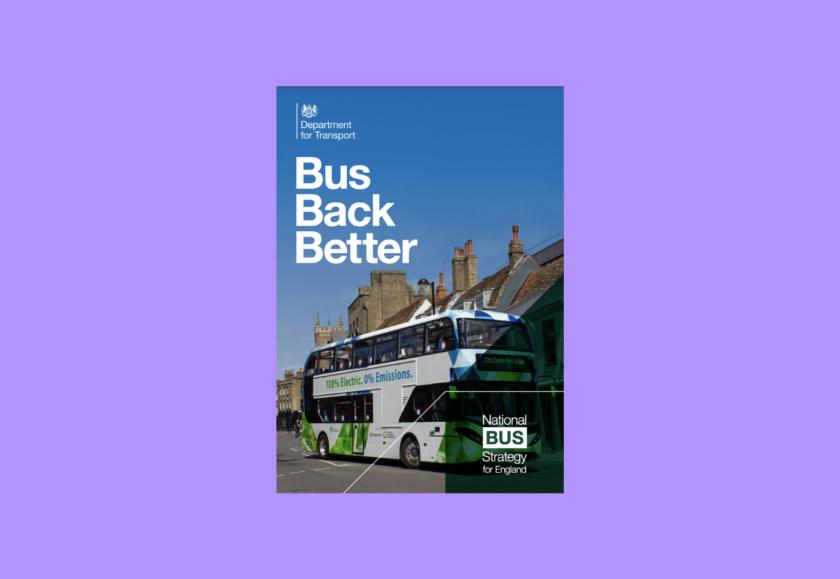The Government have published their National Bus Strategy: what does this mean for disabled people?
Katie Pennick
Transport for All's Campaigns LeadWe take a look at the Government's new Bus Back Better strategy and work out if it's good news for disabled passengers.

A few weeks ago, the Government unveiled their plans for a £3 billion shake-up of the bus sector, set out in the National Bus Strategy.
Unlike aviation, walking, and cycling, up until now there was no such national strategy for buses. With buses often being the most accessible mode of transport available to disabled people, we welcome this much-needed strategic attention, and have been closely looking at the strategy to determine what this will mean for disabled passengers.
Transport For All says:
This is a much needed and long overdue national strategy which seeks to bring the nation’s bus network up to the standard we see in London. Since deregulation in 1986 the commercial bus network outside of London has led to a patchwork and fragmented service, meaning disabled people travelling across the country have no grounds for what service to expect. Policies, bus passes, and vehicle specs differ from county to county leaving disabled passengers to fight for an accessible service on an individual basis. We are left wondering if this proposed ‘Enhanced Partnerships’ model between bus companies and Local Authorities will be enough to guarantee accessibility and reliability of services?
Elsewhere in the strategy there are several details left unchecked. We welcome the 4000 new Electric buses the Government pledges to purchase, but would like to be assured these noise-less vehicles will have audio signals to alert visually impaired people they are coming, a vital safety feature that we have seen trialed in London. Additionally, the strategy discusses plans for under-used routes to be replaced with an on-demand minibus service booked through an app, which throws up accessibility concerns that need to be addressed.
The strategy makes several bold accessibility promises: from mandating the provision of audible and visible route and next stop announcements on local bus services; to reviewing and consulting on key accessibility legislation including the PSVAR regulations; to ensuring that all buses funded by Government provide enhanced level of accessibility including a second priority space for wheelchairs. We welcome these and will be monitoring progress closely.
However we would like to see the Government go further: while the strategy pledges to continue funding free off-peak bus travel for disabled people, we would like to see this extended to peak times to support disabled passengers travelling into work.
Finally, it is heartening to see the Government acknowledge that bus infrastructure improvements should be informed by the experience of disabled people and consulted on with a range of passengers; something we have been campaigning on heavily. We are pushing for our ‘EQIA in Action’ model of engagement to be adopted by transport service providers. It is crucial when implementing bus priority measures that access is not impeded for those disabled people reliant on cars and taxis, something we have seen happening with the Streetspace schemes of the past year. We hope these lessons have been learned.
Last year, the DfT had announced £3bn of new funding to level up buses across England to match London’s standards. This strategy describes how they will use that money, and what they intend to achieve. Here we take a detailed look at what the strategy sets out.
From deregulation to… regulation?
The strategy admits that the 1980s deregulation of the bus service has been a failure, with services run on a commercial for-profit basis leading to operators themselves deciding where to run and what to charge. The strategy points to the barriers this has created: complex and confusing ticketing, poor integration, unreliable services, and the axing of services to rural areas that are financially inviable to run.
What this strategy puts forward as the solution is greater co-operation between private bus companies and Local Authorities. The cornerstone of this strategy is a roll out of ‘Enhanced Partnerships’, together with – in some areas – a franchising system like we see in London. The Government promises more details on these ‘Enhanced Partnerships’ will be published in the coming weeks, and for now states they will function similarly to franchises but with private operators having a much larger role in the arrangement. Key to the strategy is the requirement for all Local Authorities to comit to establishing Enhanced Partnerships by June 2021 in order to continue accessing vital central funding, and the obligation to publish a Bus Service Implementation Plan.
Franchising, or franchising-style arrangements, could mean that measures to improve accessibility could be made a fundamental part of franchise agreements. This could make ensuring accessibility and good customer service for disabled and older passengers a contractual obligation. This would be a fantastic step forward.
The Government want to see bus services drastically improved, and made:
- More frequent
- More reliable
- Easier to understand and use
- Better coordinated
- Cheaper
In the Government’s own words, “more like London’s.”
The strategy sets out ambitions to improve the accessibility of bus services across the UK. According to the Government, the ‘buses we want’ are to be accessible and inclusive by design (not just vehicles but stops and stations too), to have ample space for wheelchair and buggies, and to have next stop announcements.
Let’s take a closer look at the accessibility promises made in the strategy.
Improving accessibility of bus services
- Subject to final analysis, ‘Accessible Information Regulations’ will be bought in by Summer 2022, which will mandate the provision of audible and visible route and next stop announcements on local bus services. This is a hugely welcomed intervention that follows years of campaigning from disability groups.
- Apps will be made to provide passengers with accessibility data about bus stations and stops so they can make informed travel choices regarding accessibility of services. This is certainly a good idea, and we await more details on how this will be achieved in practice.
- LTAs will be expected to explicitly consider inclusivity and review impact of roadside infrastructure on roadside accessibility as part of their Bus Service Improvement Plans.
- All buses funded by Government will provide enhanced level of accessibility:
- A second priority wheelchair space (flexible)
- Hearing loops
- Space for assistance dogs
- Audible and visible information
- Eligibility for free bus travel for disabled people will be reviewed, to ensure the Government are improving equality of opportunity. The Government will look into digitising the concessionary bus pass. This is welcomed; however we would like to see the scheme extended to provide free travel for companions of bus pass holders, across all the different counties.
- Two key regulations will be reviewed to improve accessibility:
- The Public Service Vehicles Accessibility Regulations (PSVAR) will be reviewed by end of 2023.
- The Conduct of Drivers will be consulted on in 2021 to ensure wheelchair space and priority seat are always available to those who need it.
- Each Local Transport Plan will be expected to include measure that improve accessibility for disabled people.
- The design of bus infrastructure improvements should be informed by the experience of disabled people and consulted on with a range of passengers; particular care should be taken when implementing bus priority measures to ensure that they do not impede access for disabled people reliant on private motor vehicles, taxis and private hire vehicles. This is something we have been campaigning on heavily so is heartening to see; we hope that our ‘EQIA in Action’ model of engagement will be adopted by transport service providers.
- Free off-peak bus travel for disabled people will continue to be funded. Again, while this is welcomed, we would like to see this extended to cover peak-travel for disabled people, as disabled people have jobs which require commuting at peak times for.

